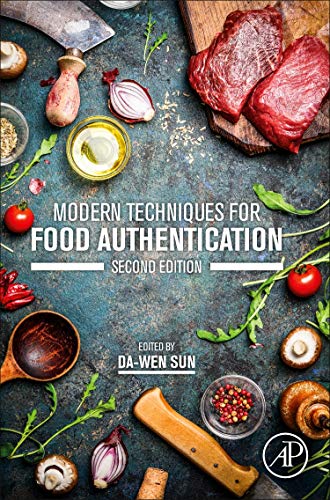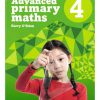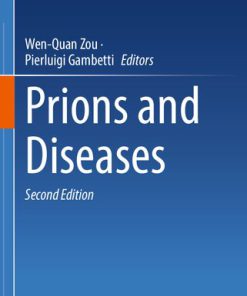Modern Techniques for Food Authentication 2nd Edition by Da Wen Sun 0128142650 9780128142653
$50.00 Original price was: $50.00.$25.00Current price is: $25.00.
Modern Techniques for Food Authentication 2nd Edition by Da Wen Sun – Ebook PDF Instant Download/Delivery: 0128142650, 9780128142653
Full download Modern Techniques for Food Authentication 2nd Edition after payment
Product details:
ISBN 10: 0128142650
ISBN 13: 9780128142653
Author: Da-Wen Sun
Modern Techniques for Food Authentication, Second Edition presents a comprehensive review of the novel techniques available to authenticate food products, including various spectroscopic technologies, methods based on isotopic analysis and chromatography, and other techniques based on DNA, enzymatic analysis and electrophoresis. This new edition pinpoints research and development trends for those working in research, development and operations in the food industry, giving them readily accessible information on modern food authentication techniques to ensure a safe and authentic food supply. It will also serve as an essential reference source to undergraduate and postgraduate students, and for researchers in universities and research institutions.
- Presents emerging imaging techniques that have proven to be powerful, non-destructive tools for food authentication
- Includes applications of hyperspectral imaging to reflect the current trend of developments in food imaging technology for each topic area
- Provides pixel level visualization techniques needed for fast and effective food sample testing
- Contains two new chapters on Imaging Spectroscopic Techniques
Modern Techniques for Food Authentication 2nd Table of contents:
Chapter 1: Introduction to Food Authentication
Abstract
1 Introduction
2 Modern Techniques in Food Authentication
3 Conclusions
Chapter 2: Spectroscopic Technique: Mid-Infrared (MIR) and Fourier Transform Mid-Infrared (FT-MIR) Spectroscopies
Abstract
1 Introduction
2 Theory and Principles
3 Instrumentation
4 Applications of MIR and FT-MIR in Foods and Drinks
5 Conclusions
Chapter 3: Spectroscopic Technique: Near Infrared (NIR) Spectroscopy
Abstract
1 Introduction
2 Theory and Principles
3 Instrumentation
4 Chemometrics
5 Advantages and Disadvantages
6 Applications in Food and Beverage Authenticity
7 Conclusions
Chapter 4: Spectroscopic Technique: Fourier Transform (FT) Near-Infrared Spectroscopy (NIR) and Microscopy (NIRM)
Abstract
1 Introduction
2 Theory and Instrumentation
3 New Trends in Chemometrics as Applied to NIR Spectroscopic Data
4 Authentication, Fraud, and Contaminant Detection by FT-NIR
5 Authentication by FT-NIRM
6 Conclusions
Chapter 5: Spectroscopic Technique: Raman Spectroscopy
Abstract
1 Introduction
2 Instrumentation
3 Applications in Agricultural and Food Sector
4 Conclusions
Chapter 6: Spectroscopic Technique: Fourier Transform Raman (FT-Raman) Spectroscopy
Abstract
1 Introduction
2 Fundamentals of Raman Spectroscopy
3 Raman Band Intensities and Basis of Qualitative Aspect of Raman Spectroscopy
4 FT-Raman Instrumentation
5 Applications of Raman Spectroscopy
6 Conclusions
Chapter 7: Spectroscopic Technique: Fluorescence and Ultraviolet-Visible (UV-Vis) Spectroscopies
Abstract
1 Introduction
2 Fluorescence Spectroscopy
3 Instrumentation
4 Applications of Fluorescence in Foods and Drinks
5 Advantages and Disadvantages of Fluorescence Spectroscopy
6 Conclusions
Chapter 8: Imaging Spectroscopic Technique: Hyperspectral Imaging
Abstract
1 Introduction
2 Theory and Principles
3 Instrumentation
4 Hyperspectral Data Analysis
5 Applications in Food Authenticity
6 Conclusions
Chapter 9: Imaging Spectroscopic Technique: Raman Chemical Imaging
Abstract
1 Introduction
2 Fundamentals of Raman Chemical Imaging
3 Applications of Raman Chemical Imaging for Food Authentication
4 Advantages and Disadvantages
5 Conclusions
Chapter 10: Isotopic-Spectroscopic Technique: Site-Specific Nuclear Isotopic Fractionation Studied by Nuclear Magnetic Resonance (SNIF-NMR)
Abstract
1 Introduction
2 Natural Isotope Fractionation
3 Determining Site-Specific Ratios by Nuclear Magnetic Resonance (NMR)
4 2H NMR for Quantitative Determinations of Site-Specific Ratios
5 Conclusions
Chapter 11: Isotopic-Spectroscopic Technique: Stable Isotope-Ratio Mass Spectrometry (IRMS)
Abstract
Acknowledgments
1 Introduction
2 Theory and Principles
3 Equipment and Instruments
4 Recent Applications in Food Authenticity
5 Strengths and Limitations
6 Applicability of Different Isotope Fingerprints to Authenticity and Geographical Origin
7 Conclusions
Chapter 12: Chromatographic Technique: Gas Chromatography (GC)
Abstract
Acknowledgments
1 Introduction
2 Theory and Fundamentals
3 Instrumentation
4 Applications
5 Conclusions
Chapter 13: Chromatographic Technique: High-Performance Liquid Chromatography (HPLC)
Abstract
1 Introduction
2 Principle of Liquid Chromatography
3 Instrumentation
4 Sample Preparation
5 Applications
6 Conclusions
Chapter 14: DNA-Based Technique: Polymerase Chain Reaction (PCR)
Abstract
1 Introduction
2 Stability of DNA in Foods
3 Methods of DNA Extraction From Foods
4 Molecular Techniques Used to Discriminate Between Similar Species and Strains
5 Species Specific PCR Assays
6 Other DNA-Based Techniques
7 Conclusions
Chapter 15: Immunoanalytical Technique: Enzyme-Linked Immunosorbent Assay (ELISA)
Abstract
1 Introduction
2 Recent Applications in Enzyme Immunoassay for Food Authentication
3 Conclusions
Chapter 16: Electrophoretic Technique: Capillary Zone Electrophoresis
Abstract
Acknowledgments
1 Introduction
2 Equipment and Instrumentation Used in CE
3 Theory and Principles of CE
4 Modes of CE
5 Application of CE to Food Authentication
6 Future Outlooks
7 Conclusions
Chapter 17: Chemometric Methods in Food Authentication
Abstract
1 Introduction
2 Data Collection
3 Data Display
4 Process Monitoring and Quality Control
5 Three-Way PCA
6 Discriminant Classification
7 Modeling
8 Calibration
9 Variable Selection
10 Future Trends
11 The Advantages and Disadvantages of Chemometrics
12 Conclusions
Chapter 18: Trends in Food Authentication
Abstract
1 Introduction
2 Emerging Authentication Methods
3 Conclusions
Index
People also search for Modern Techniques for Food Authentication 2nd:
modern food techniques
modern food technology
kqm2 task 2 using technology in the classroom
3 technological advances affecting food preparation
3 methods of authentication
Tags:
Da Wen Sun,Modern Techniques,Food Authentication
You may also like…
Medicine - Infectious diseases
Prions and Diseases 2nd Edition by Wen Quan Zou, Pierluigi Gambetti 3031205650 9783031205651
Uncategorized
The Easy Comfort Food Cookbook: Delicious Recipes for Real Comfort Food (2nd Edition) Booksumo Press
Engineering
Principles of Tribology 2nd Edition by Shizhu Wen, Ping Huang ISBN 9781119214892 1119214890
Computers - Security
Technique - Food Manufacturing
Uncategorized
Modern Computational Techniques for Engineering Applications 1st Edition Krishan Arora (Editor)
Technique - Food Manufacturing
Techniques for Food Authentication Trends and Emerging Approaches 2nd Ed Raúl González-Domínguez
Technique - Food Manufacturing
Food Safety Management: A Practical Guide for the Food Industry 2nd Edition Veslemøy Andersen

